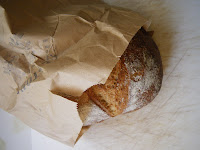The starting point for my cheese-quest was an article by Jennifer Cockrall-King on local artisan cheese makers. Between the three producers listed there, and a couple others I had heard of through friends, I had a nice list with which to start:
- Eyot Creek – near Leduc, gouda
- Natricia – Ponoka, goat cheese
- Leoni Grana – Camrose, parmesan
- Edelweiss Foods – St. Albert, camembert
- Sylvan Star – Red Deer, gouda and cheddar
- Tiras – Camrose, specializing in Greek cheeses such as feta and kefalotiri
Working through this list, trying to acquire each cheese, I found that most of them are no longer being made. My research was conducted from the chair in which I now sit, reading out-dated webpages and dialing the phone numbers that I found on them. Not crack-shot journalism, to be sure, but there were a couple of good finds. Here are my notes:
Eyot Creek – If you Google Eyot Creek, you are presented with a slough of webpages concerning an E. coli outbreak from late 2002. The sicknesses were traced back to Eyot Creek farmstead cheeses that had been sold or given away at both the Strathcona and St. Albert farmers’ markets. I could find no information on Eyot Creek dated after the E. coli outbreak. I assumed the worst and crossed Eyot Creek from my list.
[Update: I just found an article in The Leduc Representative that says Eyot Creek stopped cheese production partly because of "cost prohibitive renovations recommended by Captial Health".]
Natricia – The above-mentioned Cockrall-King article said that this Ponoka goat cheese is available at Paddy’s International Cheese Shop. I went there and asked for it by name. The girl behind the counter said that they were currently “considering” carrying Natricia, but that they hadn’t decided yet. Most likely she had no idea what I was talking about. When I got home I called the number for Natricia from an antiquated Ponoka business listing, and got the private voice mail of a Ponoka couple. Also, the url I had for the alleged Natricia website was a dead-end. Strike two.
Leoni Grana – This parmesan from Camrose is also long gone. There is a brief explanation on a forum on The Edible Prairie.
Edelweiss – Contacting Edelweiss Foods Ltd, I got the peculiar feeling that I was calling a man at his private residence (the phrase, “How did you get this number?” came up). He said that, unfortunately, he is no longer able to make cheese.
Sylvan Star – This well-known, award winning cheese is available at Planet Organics. Sylvan Star specializes in gouda and cheddar, but they also make cheese curds, if you’re a stickler for authentic poutine.
As a pretentious philhellene, I would like to go on record and say that Tiras feta (marketed as Vlahos Greek Style Feta) is fantastic. Unlike rubbery super-market feta, Tiras is soft and creamy, while retaining the characteristic feta crumble. Also, if you buy it in a large enough quantity, it's cheaper by weight than good grocery store cheeses like Cracker Barrel.







